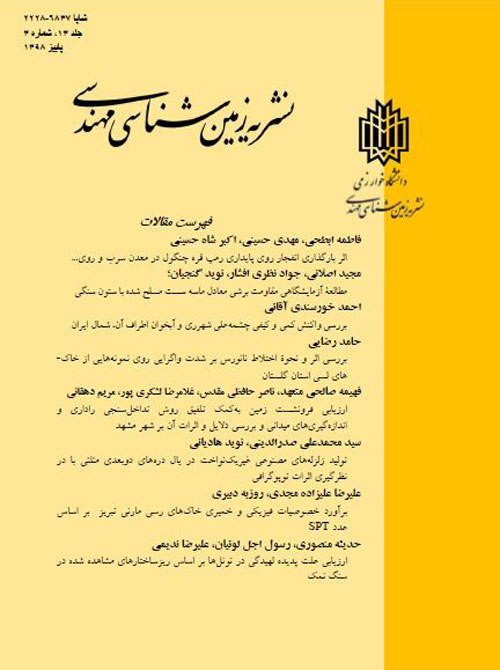Representing an Empirical Relationship for the Estimating Mode I Fracture Toughness of Rock Obtained from Testing on SCB Specimen using Tensile Strength
Author(s):
Abstract:
Extended Abstract (Paper pages157-174) Introduction Considering the fact that the estimation of mode fracture toughness by testing is time-consuming and expensive. It might be associated with certain practical difficulties. Therefore, many researchers have attempted to propose experimental relationships in order to capture these problems. Gunsallus et al. (1984) and Bhagat (1985) experimentally found that mode fracture toughness is related to tensile strength. Whittaker et al. (1992) have also proposed a number of relationships between mode I fracture toughness, tensile strength, point load index, uniaxial compressive strength and the velocity of sound waves. Bearman (1999) obtained an experimental relationship between mode I fracture toughness and point load index, while Brown et al. (1997) presented an experimental relationship between this parameter and density. Up to now no significant research effort has been made in this field in Iran, only Ayatollahi and Fatehi addressed rock fracture toughness. Although, Ayatollahi has not presented any experimental relationships. In the present research the three-point bending test was used on a cylindrical specimen containing a straight crack in order to determine the mode fracture toughness, and the Brazilian test was employed to determine tensile strength. Materials and Methods The tests were carried out on six types of rocks, namely gray sandstone, tuff, lithic tuff, travertine, andesite, and limestone. Sandstone, travertine, and limestone are sedimentary rocks, while andesite is an extrusive igneous rock, and tuff and lithic tuff are pyroclastic rocks (pyroclastic rocks resulting from volcanic eruptions that harden by sedimentation). Therefore, the studied rocks have different origins. In order to carry out the Brazilian and the three-point bending test, cores were prepared from these blocks. In order to perform the three-point bending test, specimens with diameter of 73 mm with a thickness of 30 mm were used. The samples were cut in two semicircular by a cutting machine, and a notch with length of 15 mm is created by a diamond saw. Notch is vertical in the center of the semicircular samples. The Brazilian test was performed on disc shaped specimens. In order to perform the Brazilian test, specimens with diameter of 51 mm and thick of 25 mm were used. The specimens are carefully placed under the curved jaws of the machine and then loaded until fracture. Results and Discussion A summary of the Brazilian and the three-point bending test results are presented in Table 1. The average value of test result pertaining to each rock is reported in Table 1. Table 1. Summary of the Brazilian and the three-point bending test results Specimen Tensile Strength (MPa) Fracture Toughness (MPa√m) Limestone 3.74 1.23 Sandstone 7.14 1.63 Tuff 16.36 2.17 Lithic Tuff 4.34 1.01 Andesite 13.25 1.86 Travertine 8.27 1.14 In this study, it was attempted to propose an experimental relationship between mode I fracture toughness and the tensile strength of the rock. In order to determine the relationship between the tensile strength and the fracture toughness, the tensile strength vs. fracture toughness diagram was plotted in Excel to obtain Eq. 1 and the coefficient of determination (R2) (Figure 1). K_IC=0.0812σ_t.7878 (1) R^2=0.7977 The coefficient of determination (R2) in Eq. 1 shows that almost 80 percent of the mode I fracture toughness variations can be estimated using the linear relationship (Eq. 1). The relationship is applicable for determining the mode I fracture toughness resulting from the three-point bending test on semicircular specimens containing a straight crack. In the following, the results of this study are compared to those reported by Whittacker (1992) and Zhang (2002). In order to examine the accuracy of the presented relationships, the Root Mean Square Error (RMSE) measure was used which is computed from Eq. 2. In the best case, RMSE is zero. RMSE=√(1/n ∑_(i=1)^n▒〖(y_i-〖y_i〗^')〗^2 ) (2) In the relationships, y_i represents the fracture toughness obtained from testing while 〖y_i〗^' is the fracture toughness estimated using the relationships. Comparison of the obtained results indicate that the proposed relationship has the capability of precise estimation of the mode I fracture toughness of rocks. Conclusion Given the many difficulties associated with the direct estimation of fracture toughness, indirect estimation methods have been proposed. One of such methods is the estimation of mode I fracture toughness using tensile strength. A linear relationship with a coefficient of determination of 0.7977 was proposed. The accuracy of this relationship has been verified by comparing its results to those from previous studies.
Keywords:
Language:
Persian
Published:
Journal of Engineering Geology, Volume:11 Issue: 2, 2017
Page:
157
magiran.com/p1731920
دانلود و مطالعه متن این مقاله با یکی از روشهای زیر امکان پذیر است:
اشتراک شخصی
با عضویت و پرداخت آنلاین حق اشتراک یکساله به مبلغ 1,390,000ريال میتوانید 70 عنوان مطلب دانلود کنید!
اشتراک سازمانی
به کتابخانه دانشگاه یا محل کار خود پیشنهاد کنید تا اشتراک سازمانی این پایگاه را برای دسترسی نامحدود همه کاربران به متن مطالب تهیه نمایند!
توجه!
- حق عضویت دریافتی صرف حمایت از نشریات عضو و نگهداری، تکمیل و توسعه مگیران میشود.
- پرداخت حق اشتراک و دانلود مقالات اجازه بازنشر آن در سایر رسانههای چاپی و دیجیتال را به کاربر نمیدهد.
In order to view content subscription is required
Personal subscription
Subscribe magiran.com for 70 € euros via PayPal and download 70 articles during a year.
Organization subscription
Please contact us to subscribe your university or library for unlimited access!


